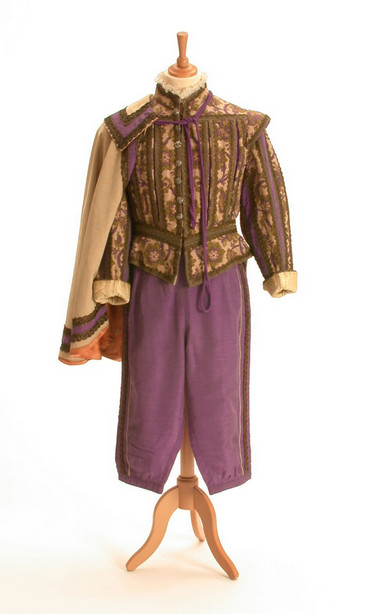Man's Doublet & Breeches, Tudor, Replica
In the Tudor period, padding, boning and stiffening was used in all clothes, for both men and women. The jacket part of the man's outfit was called a doublet. It was heavily padded to make it stand away from the body, as if the man has a paunch. This is a style we find very odd today. So much padding and stiffening restricted movement, causing men to move in a very formal way. The breeches shown here reach to the knee and were worn with stockings that were tied where they met the breeches. The outfit is completed with a short semi-circular cloak worn over one shoulder.
The fabric shown here is a modern one of rich brocade in green and purple. In the late 16th century the clothes of the rich had a lot of embroidery, often raised and using metal threads and braids as this one does. The embroidery took the form of formal interlocking patterns, sometimes with naturalistic plant and animal forms worked into parts of the design. Earlier in the 16th century stiff ruffs at the neck were fashionable, but these then gave way to much softer and smaller lace or linen collars.
The fabric shown here is a modern one of rich brocade in green and purple. In the late 16th century the clothes of the rich had a lot of embroidery, often raised and using metal threads and braids as this one does. The embroidery took the form of formal interlocking patterns, sometimes with naturalistic plant and animal forms worked into parts of the design. Earlier in the 16th century stiff ruffs at the neck were fashionable, but these then gave way to much softer and smaller lace or linen collars.



In the Tudor period, padding, boning and stiffening was used in all clothes, for both men and women. The jacket part of the man's outfit was called a doublet. It was heavily padded to make it stand away from the body, as if the man has a paunch. This is a style we find very odd today. So much padding and stiffening restricted movement, causing men to move in a very formal way. The breeches shown here reach to the knee and were worn with stockings that were tied where they met the breeches. The outfit is completed with a short semi-circular cloak worn over one shoulder.
The fabric shown here is a modern one of rich brocade in green and purple. In the late 16th century the clothes of the rich had a lot of embroidery, often raised and using metal threads and braids as this one does. The embroidery took the form of formal interlocking patterns, sometimes with naturalistic plant and animal forms worked into parts of the design. Earlier in the 16th century stiff ruffs at the neck were fashionable, but these then gave way to much softer and smaller lace or linen collars.
The fabric shown here is a modern one of rich brocade in green and purple. In the late 16th century the clothes of the rich had a lot of embroidery, often raised and using metal threads and braids as this one does. The embroidery took the form of formal interlocking patterns, sometimes with naturalistic plant and animal forms worked into parts of the design. Earlier in the 16th century stiff ruffs at the neck were fashionable, but these then gave way to much softer and smaller lace or linen collars.




















